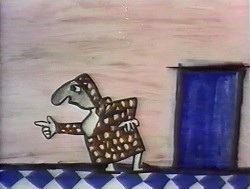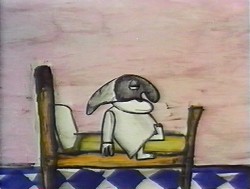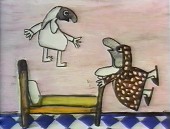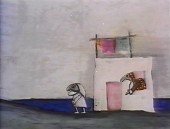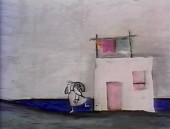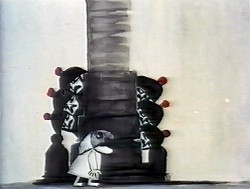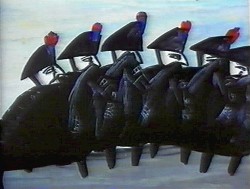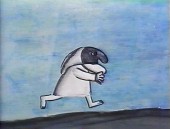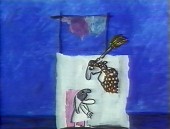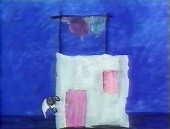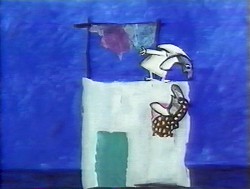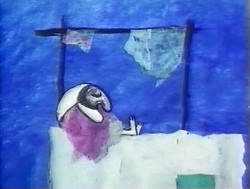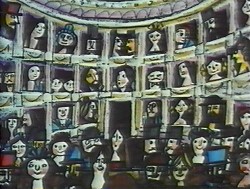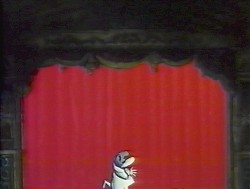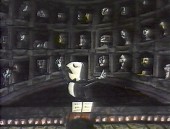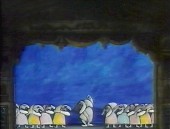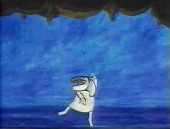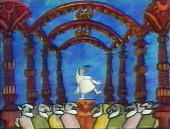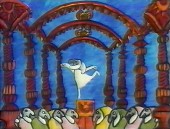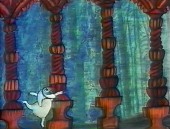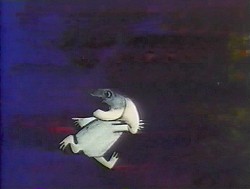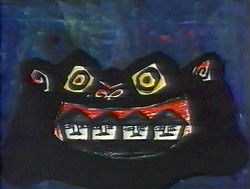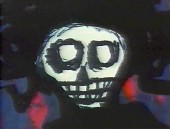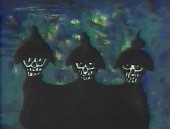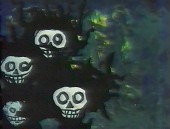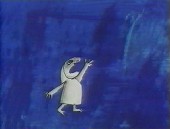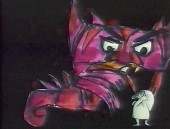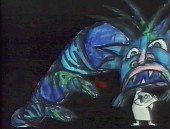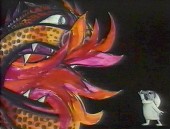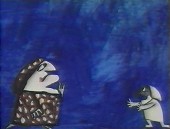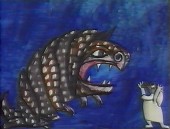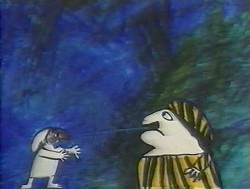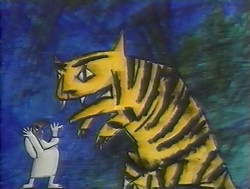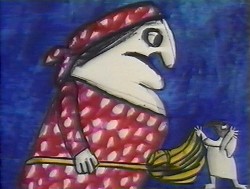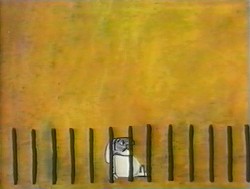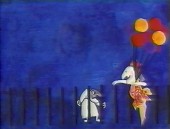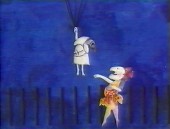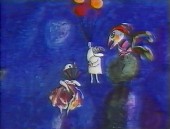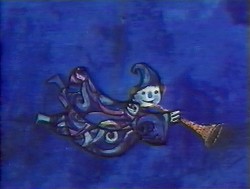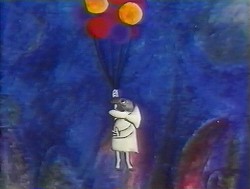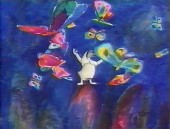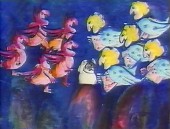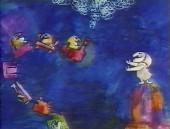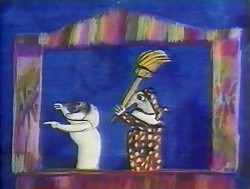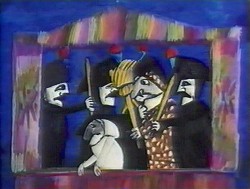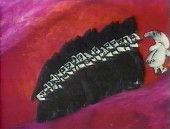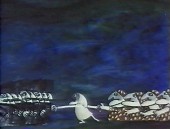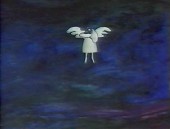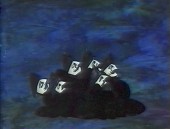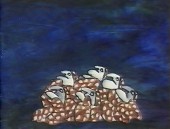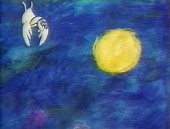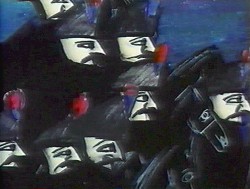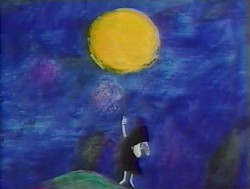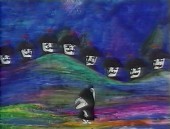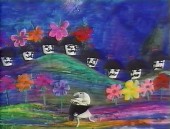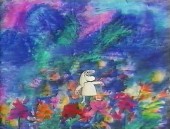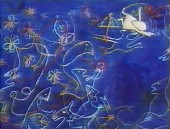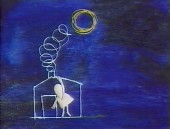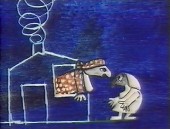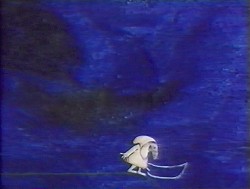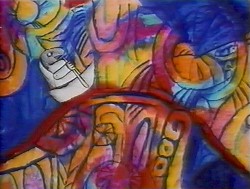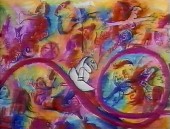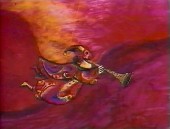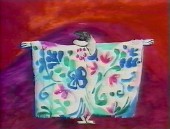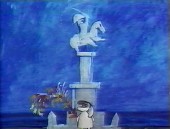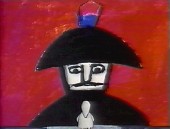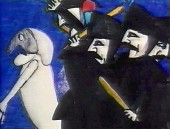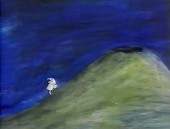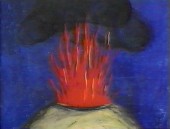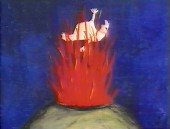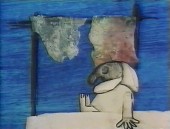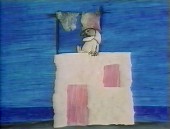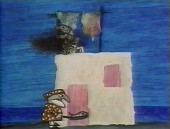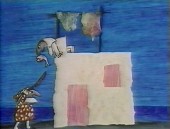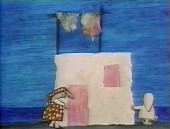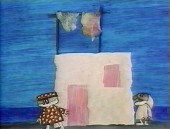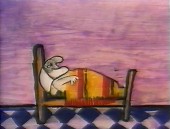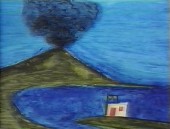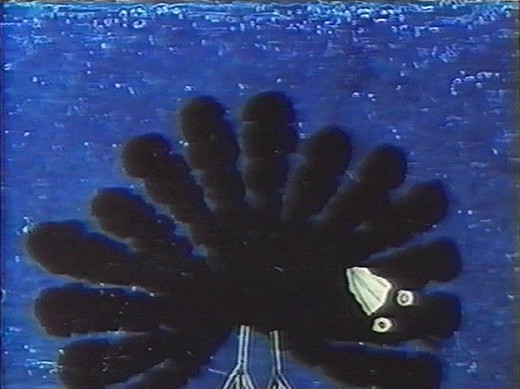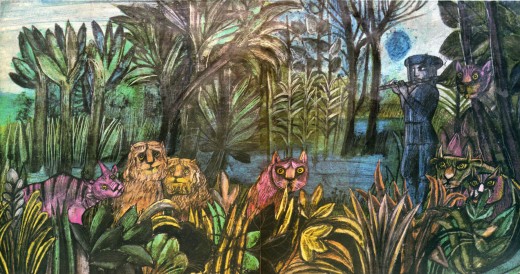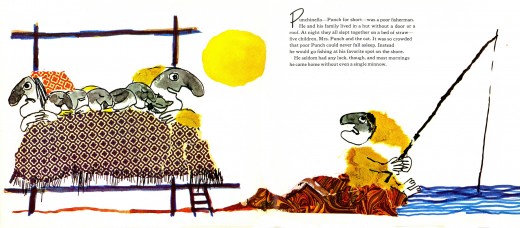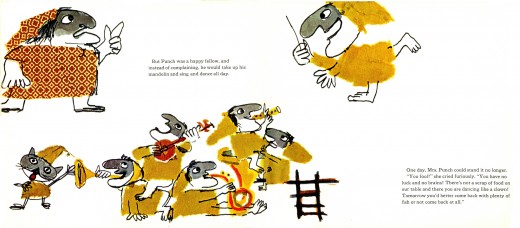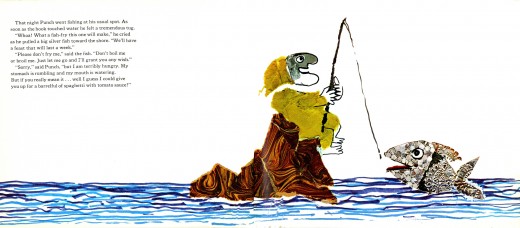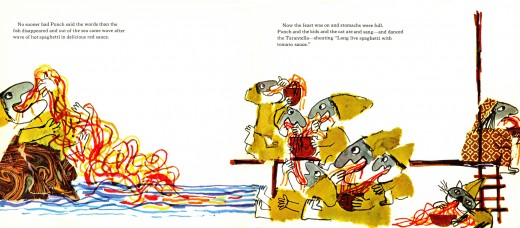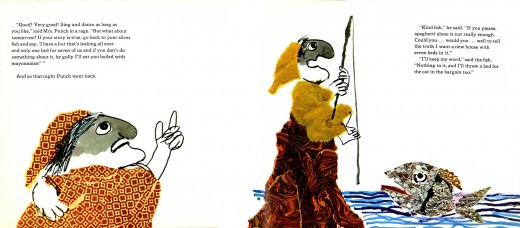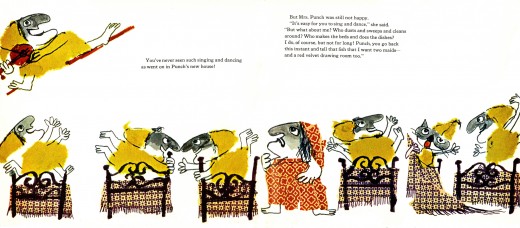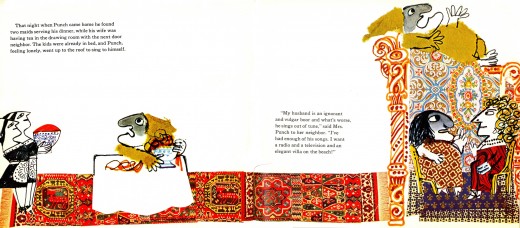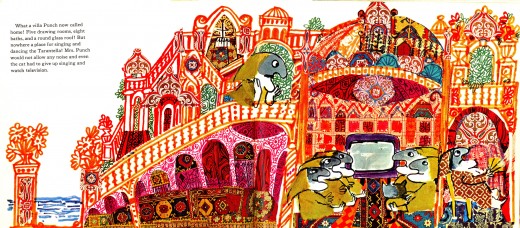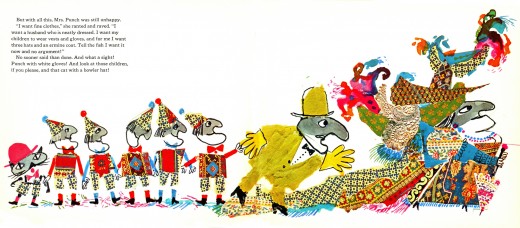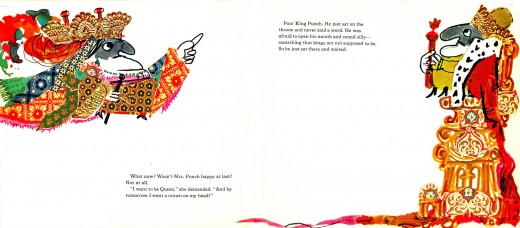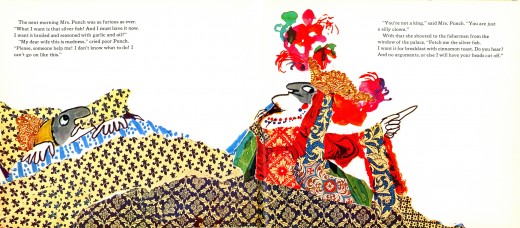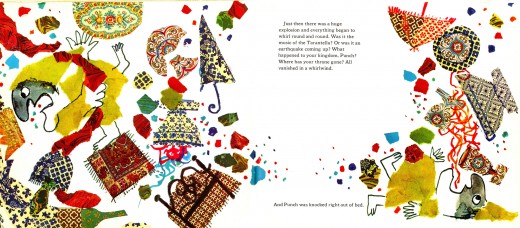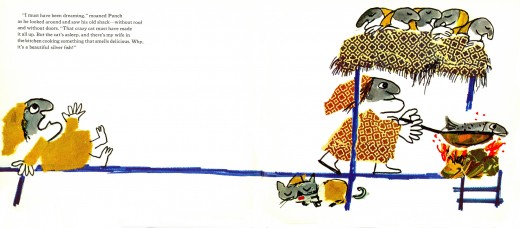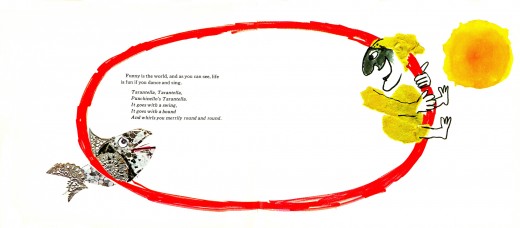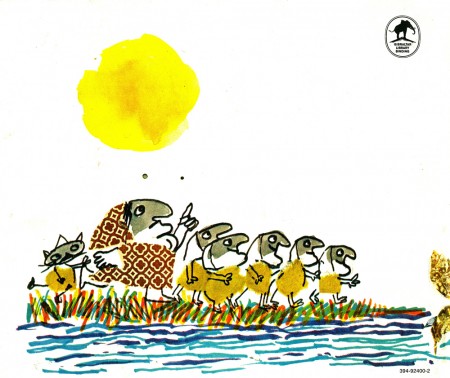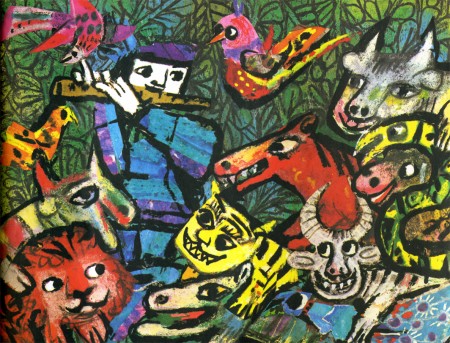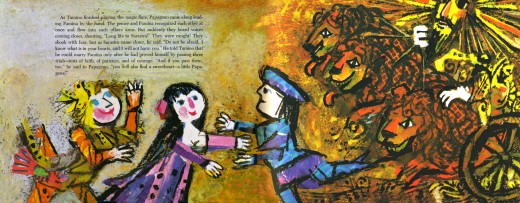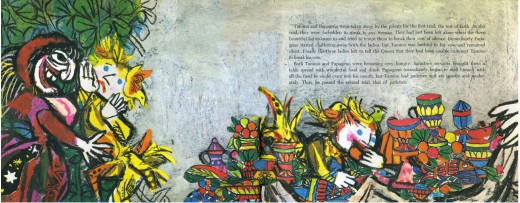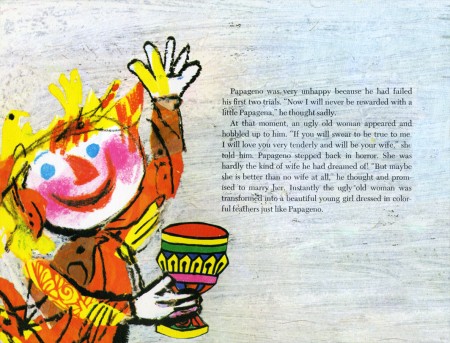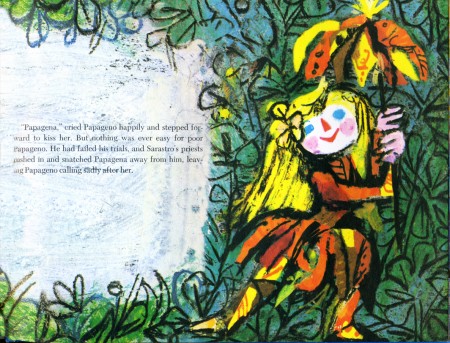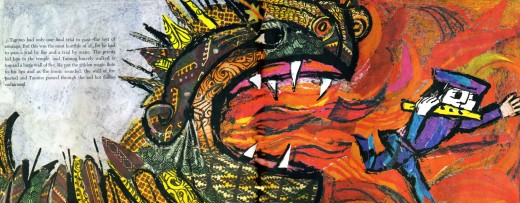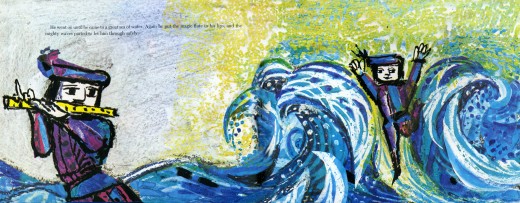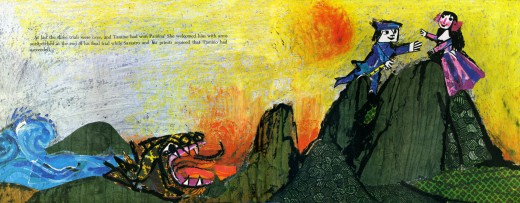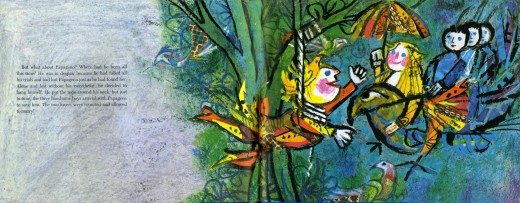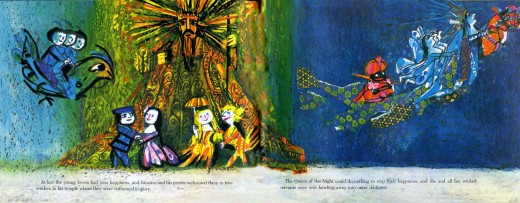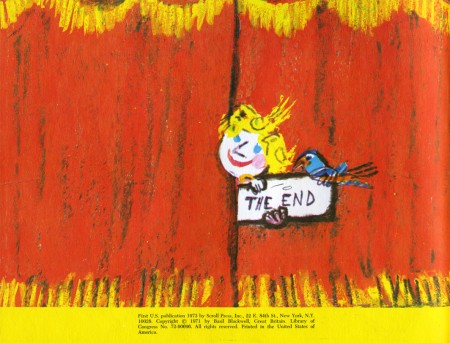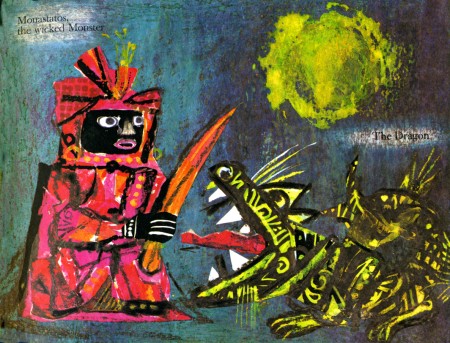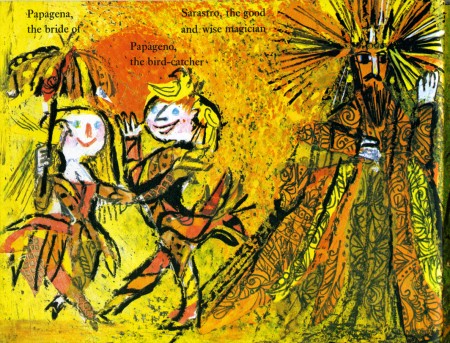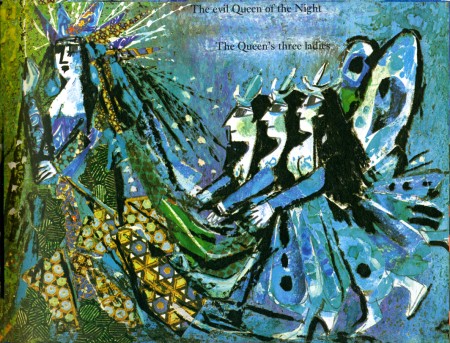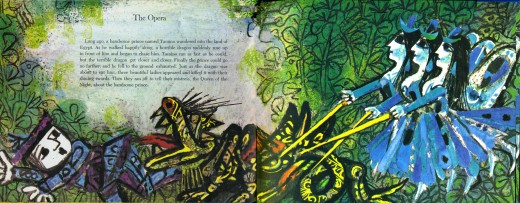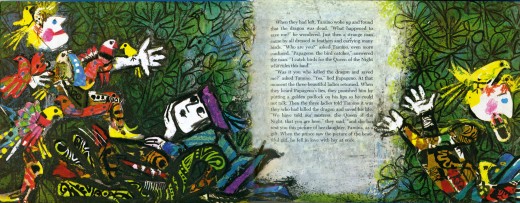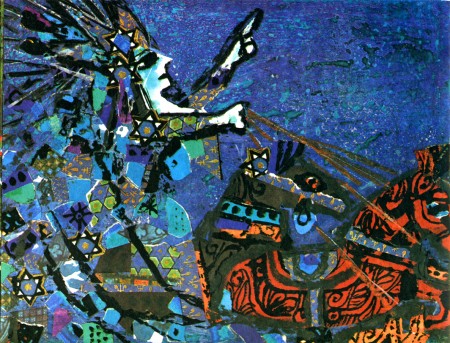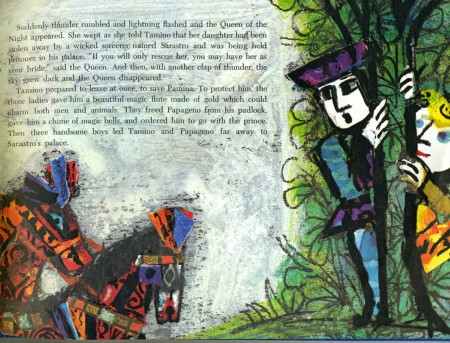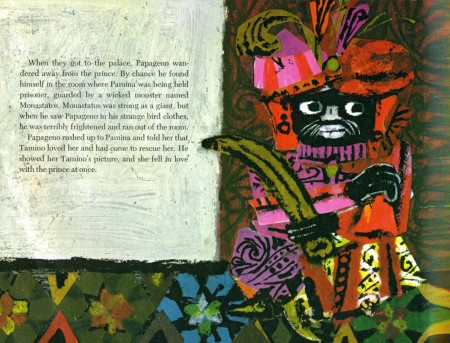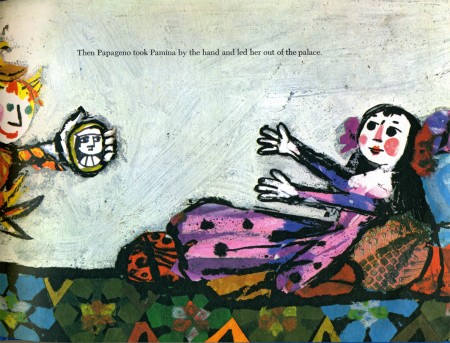Search ResultsFor "The Magic Flute"
Animation &Articles on Animation &Luzzati & Gianini &repeated posts 02 Oct 2012 04:59 am
Luzzati & Gianini
- I spent some time rereading some material about Emanuele Luzzati and Giulio Gianini. I went back into my archives and found a lot of frame grabs and a bit of info about them at the time of their individual deaths. Ive put three of those posts together and am posting that today as sort of a retrospective piece.
Luzzati
Jan. 26th, 2007
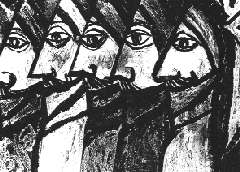 Emanuele Luzzati has died. He was the brilliant Italian designer, who worked with Giulio Gianini in creating some wonderful animated cut-out films.
Emanuele Luzzati has died. He was the brilliant Italian designer, who worked with Giulio Gianini in creating some wonderful animated cut-out films.
Their films adapted operatic overtures in reworking the operas themselves. The two were nominated for the Oscar for “The Thieving Magpie,” done in 1965 an interpretation of Rossini’s opera and again in 1973 for “Pulcinella.”
Luzzati died Jan. 26th, 2007 on the way home from work. He collapsed just outside his home. He hadn’t been ill prior to this. He spoke on the phone with Giulio Gianini, who has been very ill for some time, that very morning.
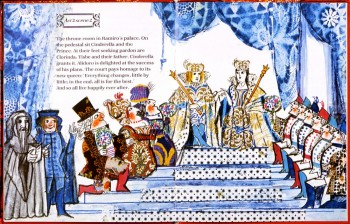 Luzzati designed sets and costumes for stage productions and operas, including the 1963 production he designed for Mozart’s “The Magic Flute.” Fifteen years later he turned the opera into an animated feature that remains one of his most famous works.
Luzzati designed sets and costumes for stage productions and operas, including the 1963 production he designed for Mozart’s “The Magic Flute.” Fifteen years later he turned the opera into an animated feature that remains one of his most famous works.
He’s illustrated and written quite a few books. See this list on Amazon.
(Above: an image from his children’s book, Cinderella.)
The only Obituary I’ve seen for him was this one for the AP. It does give rather complete details of his life and work. AP Obituary.
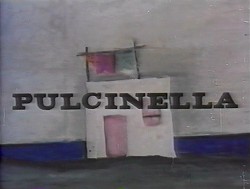 – I received a call from The Guardian in London. The newspaper was doing an obituary for Emanele Luzzati, and they couldn’t find any illustrations to color their report. They’d found some on my blog and wanted to know if they could use them.
– I received a call from The Guardian in London. The newspaper was doing an obituary for Emanele Luzzati, and they couldn’t find any illustrations to color their report. They’d found some on my blog and wanted to know if they could use them.
(Go here to see all Luzzati/Gianini posts.)
Of course, I directed them to Luzzati‘s distributor who could give the clearances they needed.
But I found it all depressing.
This was one of the world’s greatest designers of Operas and Animation. His brilliant animated version of The Magic Flute is a feature that should be in theaters now. Unfortunately, it never made it to theaters (at least, not in the US), and his designs for the opera are equally as stunning.
Years of amazing art he’s produced, and there’s so little – even on-line – that could be readily found for his obituary. I find it confusing. This was the original reason I had for putting so much attention on his work, and the call from the paper pushes me back to do another post. Unfortunately, all I have are frame grabs.
Here is Pulcinella. It is a short that was nominated for the Oscar in 1973. Another cut-out animated film, Frank Film by Frank and Caroline Mouris won the award. The Legend of John Henry by Sam Weiss, produced by Nick Busustow was also nominated.
Like other Luzzati/Gianini films, the score is taken from an opera overture, Rossini’s The Turk in Italy.
The animated film is an abbreviated, caricatured version of the opera. 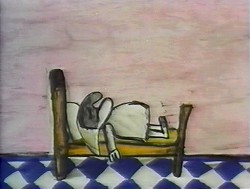
Pulcinella (Punch, as in Punch & Judy) is the principal character who dreams himself into a wild nightmare of a dream that leads us through an abstract world. It’s nice to see how the animators/designers play off the puppet character as well as the opera.
I’m just going to post the images without detailing the story. I like it better that way.
There are some 90 images, so it takes some attention to graphics.
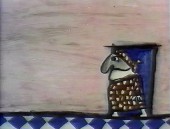
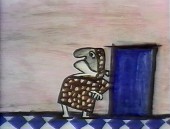
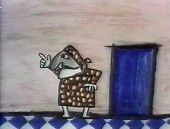
(Click any image on the page to enlarge.)
Gianini
May 18th, 2009
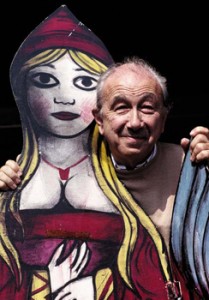 – I’ve been something of a fan of the films of Luzzati and Gianini. I’d met Emanuelle Luzzati at a function thrown at the Italian Embassy in New York, years ago. I bought a book by him, and the artist drew a beautiful pen and ink drawing in the frontispiece of the book.
– I’ve been something of a fan of the films of Luzzati and Gianini. I’d met Emanuelle Luzzati at a function thrown at the Italian Embassy in New York, years ago. I bought a book by him, and the artist drew a beautiful pen and ink drawing in the frontispiece of the book.
In 1988, I met Giulio Gianini in Italy during a stay of a couple of pleasant days with an assistant of his at the festival in Treviso, Italy.
Mr. Gianini died this past Saturday, and I wanted to offer a bit of a memorial. Emanuelle Luzzati died January, 2007 and to memorialize that I posted some illustrations and information about the duo with a lot of frame grabs from a number of the Luzzati/Gianini films. It took a few posts, and I left off without wanting to overplay all of the art at my availability.
Luzzati & friend
The Thieving Magpie was the first of their films to receive an Oscar nomination, and it was the first of the frame-grab posts I showcased. I’d like to post it again in honor of Mr. Gianini. He was sick for several years and in particularly bad condition. His death wasn’t a surprise, but it is still an enormous loss.
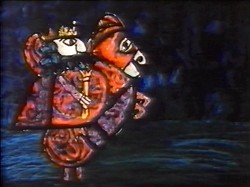 1
1 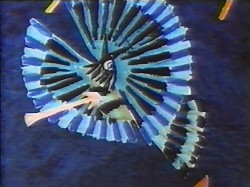 2
2(Click any image to enlarge.)
La Gazza Ladra (The Thieving Magpie) is a Rossini opera about a young maidservant who, accused of stealing a silver spoon, is sentenced to death for her crime.
At the eleventh hour, the real culprit is found to be a magpie.
A cartoon, if ever there was one. With great music!
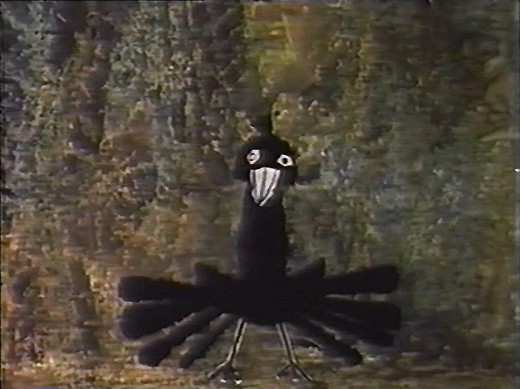
The film tells a tale wherein a king and his hunters, on a bird hunt, are beaten
by a magpie who steals their gems and ultimately destroys their village.
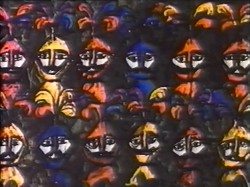 4
4 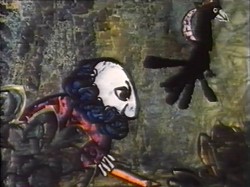 5
5
Luzzati who spent many years designing operas and ballets,
brought his knowledge to animation as the pair adapted several operas often utilizing the overtures of the operas they were adapting.
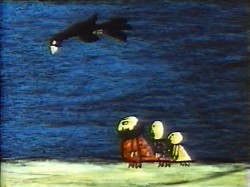 6
6 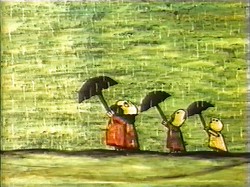 7 The film was nominated in 1964 along with
7 The film was nominated in 1964 along with
Clay, and the Origin of the Species by Eliot Noyes
and the winner, Chuck Jones’ Dot and the Line.
The Sound of Music won the Best Picture Oscar, that year.
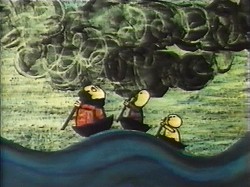 8
8 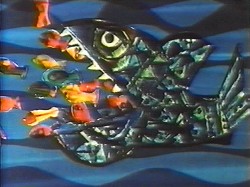 9 The use of cut-out animation wasn’t mainstream at the time.
9 The use of cut-out animation wasn’t mainstream at the time.
This is years before Terry Gilliam made it somewhat fashionable. All of the
Luzzati-Gianini films were totally inventive and creative within the form they established.
Gianini’s animation was as dreamlike as Luzzati’s exciting designs. The films
look to be designed somewhere between Chagall, Kirchner and
stained-glass windows; the sensibilities are all Luzzati and Gianini.
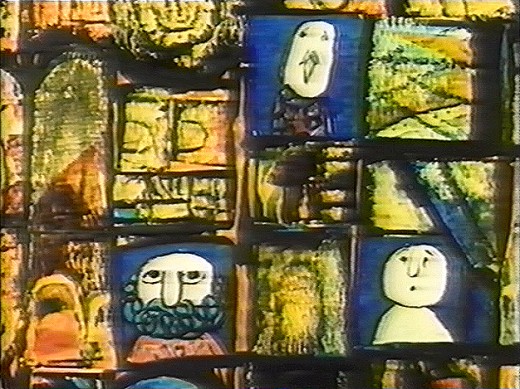 Today we have Flash animation which does just about the same thing as cut-out animation, but the form used today is flat and vulgar and cartoony. It might be useful for practitioners of Flash to take a good look at what these two brilliant designer/animators did with a similar form under more complex and arduous methods. Ulltimately, it’s all related.
Today we have Flash animation which does just about the same thing as cut-out animation, but the form used today is flat and vulgar and cartoony. It might be useful for practitioners of Flash to take a good look at what these two brilliant designer/animators did with a similar form under more complex and arduous methods. Ulltimately, it’s all related.
You can get a bit more information about Gianini and Luzzati from the website of the Luzzati Museum in Genova.
Music &Photos &SpornFilms 10 Oct 2010 07:59 am
Jazzy Bones
 The Amazing Bone was one of the earlier films I did with Weston Woods. It was an attempt to do Doctor DeSoto one better by taking a more famous book by Steig and adding some richer animation and a lot more attention. John Lithgow was hired to read the book. I flew to LA and back in the same day to get to the recording. (I could’ve done it by phone, but where’s the fun in that?)
The Amazing Bone was one of the earlier films I did with Weston Woods. It was an attempt to do Doctor DeSoto one better by taking a more famous book by Steig and adding some richer animation and a lot more attention. John Lithgow was hired to read the book. I flew to LA and back in the same day to get to the recording. (I could’ve done it by phone, but where’s the fun in that?)
We recorded at the old A&M studio. It was originally Charlie Chaplin’s studio and had ultimately come into the hands of Herb Alpert. I
was early; Lithgow was on time. Our recording engineer was named “Magic.” John read the part brilliantly with few needed retakes. 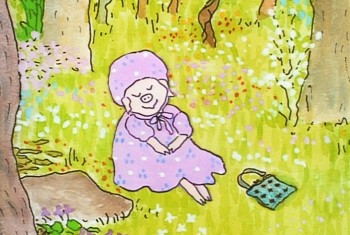 He kept in character for all the voice changes as he read straight ahead. We finished early, and I had a great voice track. I remember exactly the tone of voice when he said goodbye to me, then to “Magic.” He voiced the quotation marks around Magic’s name. I could only smile.
He kept in character for all the voice changes as he read straight ahead. We finished early, and I had a great voice track. I remember exactly the tone of voice when he said goodbye to me, then to “Magic.” He voiced the quotation marks around Magic’s name. I could only smile.
It was a beautiful day, and I had a couple of hours to waste before I had to return my car. So I spent time driving; I love to drive. A lot of touring around Beverly Hills. I remember driving down one quiet street lined with palm trees, and suddenly I realized there was an old clunker of a car tailgating me. I couldn’t imagine what the hell was going on. Then I realized someone was shouting my name. I stopped.
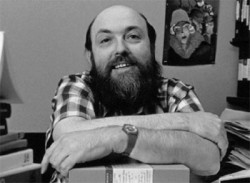 It was Bill Moritz. He came out gave me a big hug; we chatted for a moment, and he went on his way. It was one of those perfect kind of days. I knew Bill because of his association with Elfriede Fishinger. We’d had dinner countless times in NY with John Canemaker and Joe Kennedy.
It was Bill Moritz. He came out gave me a big hug; we chatted for a moment, and he went on his way. It was one of those perfect kind of days. I knew Bill because of his association with Elfriede Fishinger. We’d had dinner countless times in NY with John Canemaker and Joe Kennedy.
After a brief chat, Bill went on his way, and I continued my lovely afternoon heading back to the airport. It was one of those wonderful days.
The voice track was brilliant when finally edited together and the animation began. We decided to record the music early on in the process. I’d agreed verbally to use Steig’s son, Jeremy, to do the score. I had been a fan of his flute music and owned several of his albums.
The score was performed completely by Jeremy Steig and 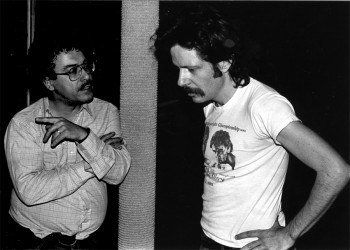 the noted bass player Eddie Gomez.
the noted bass player Eddie Gomez.
As a fan of jazz, it was glorious for me to be working with Eddie Gomez, who had once been a member of the Bill Evans Trio. I lived and breathed through Bill Evans‘ music for a long time, and to have only one degree of separation was something I cherished for the short span of that Amazing Bone recording.
(click on any image to enlarge.)
Above:Eddie Gomez confers with Jeremy Steig about the score they’re composing & performing.
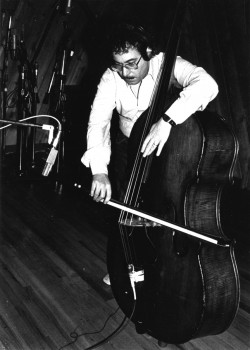
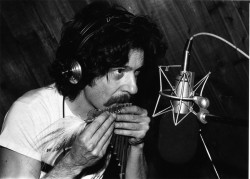 2
2 3
3
1. Eddie Gomez plays his bass.
2. Jeremy Steig plays pan pipes.
3. Jeremy Steig plays assorted bottles.
The score took about 7 hours to record and mix.
There were many breaks for Eddie and Jeremy to confer in the bathroom. It got to the point where the engineer/mixer asked them to please stay in the recording session because the breaks were taking longer than the session. They bristled at his comments, and I had to settle things down. However, the more the two went to the bathroom, the slower things got and the music took longer to record. I let things take their own course; the two knew what they had to do.
Regardless, I didn’t care what it took. I was in heaven experiencing the music. The two performers did a great job, and I loved every moment.
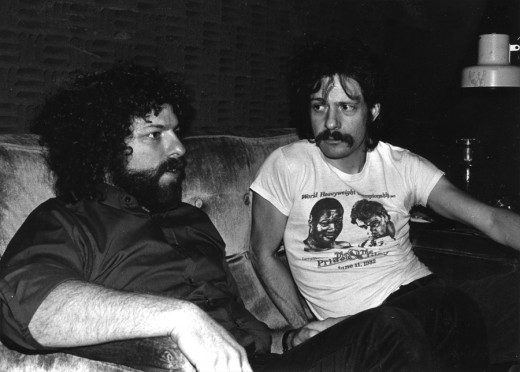
During a break Jeremy and I sat down to discuss the music so far. It was great.
All photos were taken by the producer, Paul Gagne. He’s become a long-time friend. I thought I remembered a photo of him with Jeremy, but I don’t have it.
When I did Abel’s Island, another William Steig book, I asked for Jeremy again. This time it turned into hell with Jeremy’s impossible demands late in the production, his new wife writing me foul-mouthed letters, and my having to fire them (although I did pay them in full) four days before the scheduled mix. I hired the talented Arthur Custer to do a score and he had those four days and half the budget Jeremy was paid. I became a full-fledged producer with that decision, and I’m ecstatic with how it ultimately turned out. Despite threats of legal action from William and Jeremy Steig. That was the last Steig book I was allowed to do.
Articles on Animation &Luzzati & Gianini &Puppet Animation 22 Jun 2010 07:08 am
Magic Flute
Issue #7 of ANIMAFILM included an article about the Gianini/Luzzati feature, The Magic Flute. To keep the names of these greats in the present, I’m posting the article here. Enjoy.
by Massimo Maisetti
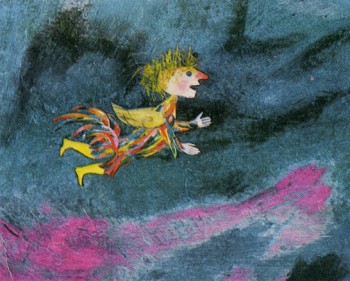 The “Magic Flute” was Mozart’s last opera, written not for the court theatre in the centre of Vienna, but for a theatre situated at the outskirts, whose manager was Schikaneder, author of the libretto. Giorgio Strehler said that it was one of the most complex and most universal works, which could be approached both from the position of the performer and the spectator. The libretto, inspired by oriental short stories, published in 1786, and by abbot Terrason’s novel, stirs up imagination, intelligence, feelings and the sense of ethics. Goethe wrote that one needed more culture to admit the values of the libretto than to deny their existence. This opinion should be thought over, as it deals with the performance staged at the outskirts in the period when to acknowledge values of a “folk” work was to oppose the accepted norms.
The “Magic Flute” was Mozart’s last opera, written not for the court theatre in the centre of Vienna, but for a theatre situated at the outskirts, whose manager was Schikaneder, author of the libretto. Giorgio Strehler said that it was one of the most complex and most universal works, which could be approached both from the position of the performer and the spectator. The libretto, inspired by oriental short stories, published in 1786, and by abbot Terrason’s novel, stirs up imagination, intelligence, feelings and the sense of ethics. Goethe wrote that one needed more culture to admit the values of the libretto than to deny their existence. This opinion should be thought over, as it deals with the performance staged at the outskirts in the period when to acknowledge values of a “folk” work was to oppose the accepted norms.
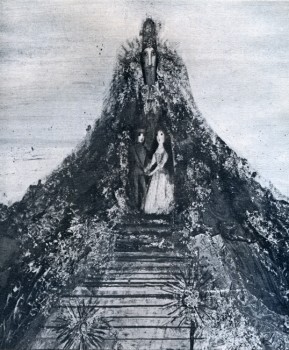 The opera, performed for the first time on September 30th, 1791, has many elements aimed at entertaining less sophisticated audience. Next to the drama of Tamino and Pamina, which is the embodiment of the eternal conflict between Right and Wrong, the Sun and Darkness, next to esoteric elements, connected with the doctrine of freemasons, which both Mozart and Schikaneder professed, there is a counterpoint – Papageno, a purely folk character from commedia dell’arte. The opera has many aspects, but the most visible ones are its fabulous and folk aspects, and next to them – metaphysical, symbolic and cosmic aspects with their Egyptian and Hellenistic associations, making one “gravitate towards one’s conscience”, according to Kirkegaard’s words. Thus to screen the “Magic Flute” was a very difficult task, as the authors of the film rejected the possibility of screening the theatre performance. It was also difficult because they had to use a chromatic and graphic language, animating drawings, where culture and experience should be combined with great sensitiveness and invention.
The opera, performed for the first time on September 30th, 1791, has many elements aimed at entertaining less sophisticated audience. Next to the drama of Tamino and Pamina, which is the embodiment of the eternal conflict between Right and Wrong, the Sun and Darkness, next to esoteric elements, connected with the doctrine of freemasons, which both Mozart and Schikaneder professed, there is a counterpoint – Papageno, a purely folk character from commedia dell’arte. The opera has many aspects, but the most visible ones are its fabulous and folk aspects, and next to them – metaphysical, symbolic and cosmic aspects with their Egyptian and Hellenistic associations, making one “gravitate towards one’s conscience”, according to Kirkegaard’s words. Thus to screen the “Magic Flute” was a very difficult task, as the authors of the film rejected the possibility of screening the theatre performance. It was also difficult because they had to use a chromatic and graphic language, animating drawings, where culture and experience should be combined with great sensitiveness and invention.
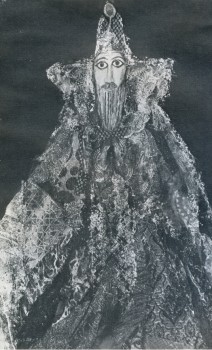 Giulio Gianini and Emanuele Luzzati are among the few film-makers in the world, who can perform such a task successfully. Gianini is an animator. He is an organizer, who is able to subordinate the technique to creative requirements. His characters move like puppets against the scenography. Its colour scheme is joy, music and charm. Those colours are the invention of the scenographer Luzzati, and Gianini, the master of photography (Nastro d’Argento for best colour photography in 1952), can reproduce them using his miraculous alchemic recipes. It was not a mere chance that many years ago at the Festival in Gildenbourgh he worked on Mo/art’s operas: “Don Juan”, “Abduction from Serai”, “Cos! fan Tutte” and “Magic Flute”. “I have always wanted to make such a film since the day I worked on that scenography”, says Luzzati. Twelve years of preparations, two years of work financed by the German and Austrian television, work done with patience, skill and imagination. At least three of Gianini’s and Luzzati’s films, first films of that kind, are characterized by a perfect relation between the music and the image: “La Gazza ladra”, “L’ltaliana in Algeri” and “Pulcinella”, where the charming music happily underlines the fancy, lyrical approach and ironical reserve.
Giulio Gianini and Emanuele Luzzati are among the few film-makers in the world, who can perform such a task successfully. Gianini is an animator. He is an organizer, who is able to subordinate the technique to creative requirements. His characters move like puppets against the scenography. Its colour scheme is joy, music and charm. Those colours are the invention of the scenographer Luzzati, and Gianini, the master of photography (Nastro d’Argento for best colour photography in 1952), can reproduce them using his miraculous alchemic recipes. It was not a mere chance that many years ago at the Festival in Gildenbourgh he worked on Mo/art’s operas: “Don Juan”, “Abduction from Serai”, “Cos! fan Tutte” and “Magic Flute”. “I have always wanted to make such a film since the day I worked on that scenography”, says Luzzati. Twelve years of preparations, two years of work financed by the German and Austrian television, work done with patience, skill and imagination. At least three of Gianini’s and Luzzati’s films, first films of that kind, are characterized by a perfect relation between the music and the image: “La Gazza ladra”, “L’ltaliana in Algeri” and “Pulcinella”, where the charming music happily underlines the fancy, lyrical approach and ironical reserve.
All this was expressed with the help of images in an apologue, in a stylistically sophisticated way. The above mentioned films are among the most interesting effects of using the technique of “decoup-age” in the history of animated cartoons, especially animated fairy tales. Both Gianini and Luzzati turned out to be great artists in synchronizing movements with the music of the three operas and creating three symphonies of lines and colours. Kings, soldiers, Moors, dragons and birds from those beautiful stories, created by Luzzati’s imagination come alive thanks to Gianini’s technique and move in the rhythm, forced upon them by the music and often interpret the music with the help of ballet. In this sense Rossini’s operas helped in the realization of the “Magic Flute”.
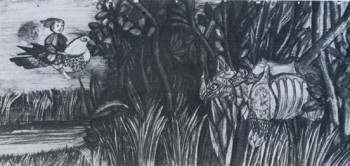 Mickey Rose, an English musicologist, made a fifty minute-long abbreviation of the opera, performed by Berlin Philharmonic, conducted by Karl Boehm, preserving its most vital elements. At the same time the graphics enriches fantastic and folk aspects with expression. It was done with charm, amazing clearness and respect for the music. When the artists use the technique of decoupage paper becomes gold, glass becomes diamond and colours become rich and luminous, like Mozart’s music. It reminds us of such great modern painters as Rouault, Chagall, Picasso, Kandinsky, as well as of oriental wall paintings, Byzantine mosaics, story, creating a naturally composed style, rich in different shades, -where a brilliant visual side interprets and completes Mozart’s wonderful music. Finally the fairy tale aspect predominates over the symbolic aspect, also due to the character of Papageno, who plays a double role: of a paper character and a live narrator (actor Marcello Bartoli). This character in multicoloured feathers reminds its famous classic ancestors. The grandson of Harlequin and Pulcinella becomes the hero of the story, determining its character. Thus the romantic story of Tamino and Pamina concentrates the philosophic sense, which is shown in the form of a fairy tale, and is meant for a demanding audience. But the simple first layer of the film pleases children, like the films “Turandot” and “L’Augellin Belverde”, screened by Gianini and Luzzati in a similar style and technique. About seventy thousand photograms with their immobile and mobile parts, three hundred drawings of the background, creative power and enthusiasm of the authors make a work of art, which is a credit to the Italian cartoon film and deserves emotions, enthusiasm and approval.
Mickey Rose, an English musicologist, made a fifty minute-long abbreviation of the opera, performed by Berlin Philharmonic, conducted by Karl Boehm, preserving its most vital elements. At the same time the graphics enriches fantastic and folk aspects with expression. It was done with charm, amazing clearness and respect for the music. When the artists use the technique of decoupage paper becomes gold, glass becomes diamond and colours become rich and luminous, like Mozart’s music. It reminds us of such great modern painters as Rouault, Chagall, Picasso, Kandinsky, as well as of oriental wall paintings, Byzantine mosaics, story, creating a naturally composed style, rich in different shades, -where a brilliant visual side interprets and completes Mozart’s wonderful music. Finally the fairy tale aspect predominates over the symbolic aspect, also due to the character of Papageno, who plays a double role: of a paper character and a live narrator (actor Marcello Bartoli). This character in multicoloured feathers reminds its famous classic ancestors. The grandson of Harlequin and Pulcinella becomes the hero of the story, determining its character. Thus the romantic story of Tamino and Pamina concentrates the philosophic sense, which is shown in the form of a fairy tale, and is meant for a demanding audience. But the simple first layer of the film pleases children, like the films “Turandot” and “L’Augellin Belverde”, screened by Gianini and Luzzati in a similar style and technique. About seventy thousand photograms with their immobile and mobile parts, three hundred drawings of the background, creative power and enthusiasm of the authors make a work of art, which is a credit to the Italian cartoon film and deserves emotions, enthusiasm and approval.
Books &Illustration &Luzzati & Gianini 29 Apr 2009 07:42 am
Luzzati’s Magic Fish
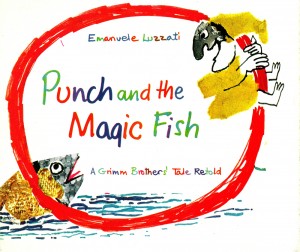 - Last week I posted a book byEmauele Luzzati, The Magic Flute. (Part 1, Part 2)
- Last week I posted a book byEmauele Luzzati, The Magic Flute. (Part 1, Part 2)
This was an adaptation of the feature film he did with Giulio Gianini. Luzzati also did a number of other children’s books (aside from all the animated films, as well as the theater and opera designs he did). None, that I know of, were pure adaptations of his film work. However, he did build on the character Pulcinello (Punch) to develop his story around Grimm tales.
Here’s a version of Punch and the Magic Fish, first published in English in 1972.
Most of the book is done as two-page spreads. I didn’t separate them. As with his past work, Luzzati uses a lot of mixed media. It looks like marker was the primary tool he used.
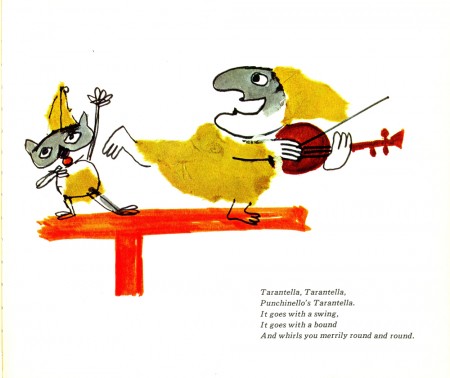 pg 1
pg 1(Click any image to enlarge.)
Books &Illustration &Luzzati & Gianini 17 Apr 2009 07:51 am
The Magic Flute – 2
- This post concludes the images from The Magic Flute, a book by Emauele Luzzati. The illustrations are reworked sketches and drawings done for the animated feature he did with animator, Giulio Gianini in 1978.
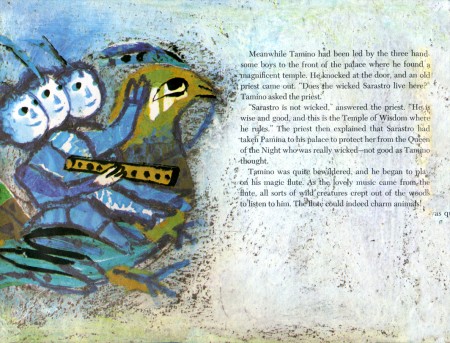 13
13(Click any image you’d like to enlarge.)
Books &Illustration &Luzzati & Gianini 16 Apr 2009 08:06 am
The Magic Flute – 1
- Emanuele Luzzati teamed with animator Giulio Gianini many times to produce some of the most beautiful films of the 60s & 70s. Their feature version of The Magic Flute completed in 1978 was also adapted into a book by Luzzati. He’d done the sets and costumes for a version of the opera in 1963.
The film didn’t get the attention it deserved, and it remains hard to locate. A small snippet is incorporated into a video on YouTube. (The animation doesn’t come on until about a minute of the piece.)
I originally saw the film when it once aired on local WNET (PBS station). It wasn’t repeated and video wasn’t available back then. However, I do have the children’s book which Luzzati published from his designs for the animation.
Here are the first half of the illustrations in the book.
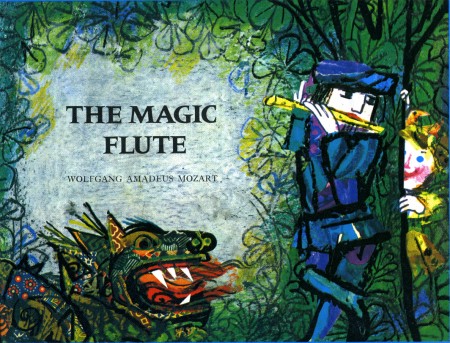
(Click any image to enlarge.)
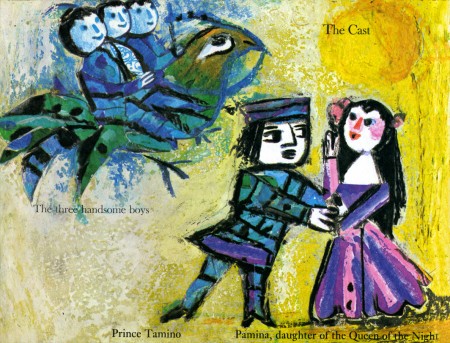 1
1
I left the type in the illustrations, though it’s a bit hard to read.
To be concluded tomorrow.
Luzzati & Gianini 04 Apr 2007 08:18 am
Pulcinella
 – I received a call from The Guardian in London. The newspaper was doing an obituary for Emanele Luzzati, and they couldn’t find any illustrations to color their report. They’d found some on my blog and wanted to know if they could use them.
– I received a call from The Guardian in London. The newspaper was doing an obituary for Emanele Luzzati, and they couldn’t find any illustrations to color their report. They’d found some on my blog and wanted to know if they could use them.
(Go here to see all Luzzati/Gianini posts.)
Of course, I directed them to Luzzati‘s distributor who could give the clearances they needed.
But I found it all depressing.
This was one of the world’s greatest designers of Operas and Animation. His brilliant animated version of The Magic Flute is a feature that should be in theaters now. Unfortunately, it never made it to theaters (at least, not in the US), and his designs for the opera are equally as stunning.
Years of amazing art he’s produced, and there’s so little – even on-line – that could be readily found for his obituary. I find it confusing. This was the original reason I had for putting so much attention on his work, and the call from the paper pushes me back to do another post. Unfortunately, all I have are frame grabs.
Here is Pulcinella. It is a short that was nominated for the Oscar in 1973. Another cut-out animated film, Frank Film by Frank and Caroline Mouris won the award. The Legend of John Henry by Sam Weiss, produced by Nick Busustow was also nominated.
Like other Luzzati/Gianini films, the score is taken from an opera overture, Rossini’s The Turk in Italy.
The animated film is an abbreviated, caricatured version of the opera. 
Pulcinella (Punch, as in Punch & Judy) is the principal character who dreams himself into a wild nightmare of a dream that leads us through an abstract world. It’s nice to see how the animators/designers play off the puppet character as well as the opera.
I’m just going to post the images without detailing the story. I like it better that way.
There are some 90 images, so it takes some attention to graphics.



(Click any image on the page to enlarge.)
Art Art &Comic Art &Daily post 03 Apr 2007 08:46 am
MOMA movement
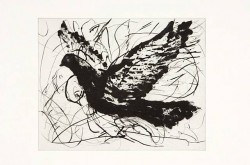 – The Museum of Modern Art has a big schedule of films and artwork upcoming:
– The Museum of Modern Art has a big schedule of films and artwork upcoming:
On Tuesday, Apr 17, 2007 at 6:30 PM, they will host an “Artists Speak” session:
Conversations on Contemporary Art with Laurie Anderson and William Kentridge as host by MOMA’s Glenn D. Lowry.
Performance artist Laurie Anderson and William Kentridge – director and scene designer for BAM’s spring production of Mozart’s The Magic Flute – discuss how they bring their creative process to performance. 
To reserve tickets go here.
Kentridge‘s The Magic Flute will play at the Brooklyn Academy of Music for four performances beginning April 9th. Kentridge directed and designed it and has animated pieces in his signature style throughout the program.
To see a video trailer for the opera go here.
To buy tickets to the Opera go here.
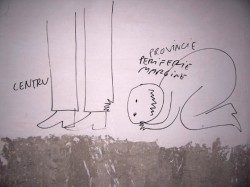 The Museum also has what it calls Projects 85. You can see Romanian artist Dan Perjovschi draw his “spontaneous” art on the walls of MOMA.
The Museum also has what it calls Projects 85. You can see Romanian artist Dan Perjovschi draw his “spontaneous” art on the walls of MOMA.
“For two weeks prior to the official opening, April 19, Perjovschi will draw on the wall during public hours, allowing visitors to observe the creation of the work.” This work will then be exhibited from May 2 thru August 27, 2007.
Of course, one of the earliest 20th Century quick-draw artists was Winsor McCay. He performed on Vaudeville stages with a large pad telling his stories which he illustrated live. Eventually, he added the animated backdrops of his cartoon characters.
Finally, regarding MOMA, I wanted to point out that they’re just starting a complete retrospective of the films of Rainier Werner Fassbinder. If you don’t know his films, you should. If you do know his films, you get to see them again in excellent projected format. Check the museum schedule for times.
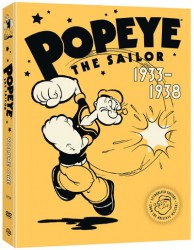
– Enough about art. Let’s talk Popeye. Warner Home Video has announced a July 31st date for the Popeye dvd: Popeye the Sailor – Volume 1: 1933-1938.
The package will include 60 cartoons plus 5 hours of bonus material: retrospectives such as “The Story of Popeye the Sailor Man” and “The History of the Fleischer Studios”. There are also “behind-the-toons” featurettes, bonus shorts, and commentary tracks by animation historians and other experts. Greg Ford directed one of the documentaries. He spoke on camera with every notable animator in New York. As one of those interviewed, I have particular reason to be interested in seeing the docs.
The Popeye shorts, themselves, will be uncut, unedited cartoons that are authorized and come from the original masters. The fact that it’s labeled volume 1, gives us good hope that other volumes will follow.
Of course, real Popeye aficionados will go back to E.C. Segar’s original strip. There’s another Popeye there that is beyond even the Fleischer shorts.
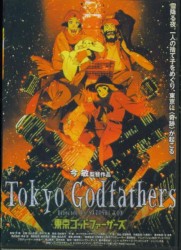 - While we wait for Satoshi Kon‘s most recent feature Paprika to open in theaters, (opens in NY May 25th/in LA June 1st) his last film Tokyo Godfathers was just released on dvd. His other features, Millenium Actress and Perfect Blue.
- While we wait for Satoshi Kon‘s most recent feature Paprika to open in theaters, (opens in NY May 25th/in LA June 1st) his last film Tokyo Godfathers was just released on dvd. His other features, Millenium Actress and Perfect Blue.
Tokyo Godfathers is another version of that John Ford classic, Three Godfathers. This same story was reworked to make Three Men and a Baby (both American and French versions) and Ice Age.
The John Ford version was a remake of the Richard Boleslawski film of the same title done in 1936. That original film, Three Godfathers, got a lot of reworking.
If you haven’t seen the trailer for Paprika watch it here.
(This is the box for the Japanese dvd.
I like it more than I do the US version.)
Animation Artifacts &Luzzati & Gianini 03 Feb 2007 08:27 am
Emanuele Luzzati
 Emanuele Luzzati has died. He was the brilliant Italian designer, who worked with Giulio Gianini in creating some wonderful animated cut-out films.
Emanuele Luzzati has died. He was the brilliant Italian designer, who worked with Giulio Gianini in creating some wonderful animated cut-out films.
Their films adapted operatic overtures in reworking the operas themselves. The two were nominated for the Oscar for “The Thieving Magpie,” done in 1965 an interpretation of Rossini’s opera and again in 1973 for “Pulcinella.”
Luzzati died Jan. 26th, 2007 on the way home from work. He collapsed just outside his home. He hadn’t been ill prior to this. He spoke on the phone with Giulio Gianini, who has been very ill for some time, that very morning.
 Luzzati designed sets and costumes for stage productions and operas, including the 1963 production he designed for Mozart’s “The Magic Flute.” Fifteen years later he turned the opera into an animated feature that remains one of his most famous works.
Luzzati designed sets and costumes for stage productions and operas, including the 1963 production he designed for Mozart’s “The Magic Flute.” Fifteen years later he turned the opera into an animated feature that remains one of his most famous works.
He’s illustrated and written quite a few books. See this list on Amazon.
(Above: an image from his children’s book, Cinderella.)
The only Obituary I’ve seen for him was this one for the AP. It does give rather complete details of his life and work. AP Obituary.
I got to meet Mr. Luzzati years ago at a function given by the Italian Embassy in his honor. He signed a copy of his book by drawing a beautiful drawing for me (which is currently in storage). Someday I’ll post it.
As someone who loves the combination of animation with music, I have long had an enormous fondness for the works of Luzzati and Gianini. It was an honor to have met him and I continue to appreciate his films. My regret his never having seen one of the many operas he designed.
His work is wildly colorful and beautifully designed. I wish I had on hand some of his images in color. I will have some images later this week and will post them. It’s amazing how little there is about him on line.
You can get a bit more information about Luzzati and Gianini from the website to the Luzzati Museum.
Art Art &Commentary &Kentridge 22 Jan 2007 08:29 am
Dodos, Kentridge & Quays
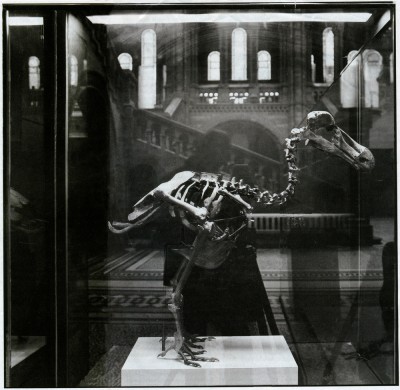
(A Dodo skeleton – Museum of Natural History, London)
Last week, The New Yorker featured an article about the dodo bird. It quite impressed me; I only wish I’d read it earlier. The online New Yorker site did not include the article, but it did feature a slideshow of paintings imagining the dodo in their natural habitat. (Not quite Bob Clampett.)
This made me wonder if hand-drawn animation is going to go a similar way. Will they be able to find the bones a hundred years from now? Evidence seen in the past five years or so seems to give me little reason to doubt that it would be gone. MoCap will get better and the guise of animation will be front and center for the obvious future. There’s a good chance tomorrow will show us two of three nominees for Oscar’s Best Animated Feature will be Motion Capture. The animator as we knew it is virtually dead.
________________________________
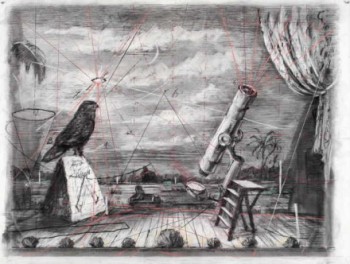 - South African artist and animator, William Kentridge, is going to be well represented at the Brooklyn Academy of Music this Spring. His production of The Magic Flute will be presented there April 9, 11, 13 and 14.
- South African artist and animator, William Kentridge, is going to be well represented at the Brooklyn Academy of Music this Spring. His production of The Magic Flute will be presented there April 9, 11, 13 and 14.
Now thru Feb 25, The Marian Goodman Gallery (24 W 57th St, 4th Fl, 212.977.7160) is showing some 50 working drawings and fragments the artist created for the visualization of this production. There are also an elaborate, preparatory theater-in-miniature which incorporates sound and projections that served as a study for a second work, Black Box/Chambre Noir (now at the Deutsche Guggenheim Berlin). “Through signature charcoal animations, Kentridge weaves his own concerns over the misplaced idealism of the colonial era into the Enlightenment masterpiece, championing fantasy as a corrective for unchecked authority.
The show at the Brooklyn Academy of Music has:
Scenery Kentridge and Sabine Theunissen, Costumes by Greta Goiris, and stars Jeremy Ovenden, Sophie Karthauser, and Stephan Loges.
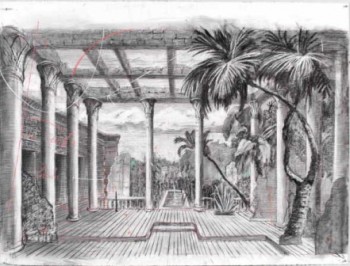 According to the program it’s . . . a mesmerizing production originally staged at Belgium’s acclaimed Royal Opera House, La Monnaie. Singers, dressed in 19th-century attire, enact a fairy tale set in an ancient Egypt populated by a high priest, a spiteful queen, a carefree bird catcher, and a heroic prince hoping to win the heart of a vulnerable princess.
According to the program it’s . . . a mesmerizing production originally staged at Belgium’s acclaimed Royal Opera House, La Monnaie. Singers, dressed in 19th-century attire, enact a fairy tale set in an ancient Egypt populated by a high priest, a spiteful queen, a carefree bird catcher, and a heroic prince hoping to win the heart of a vulnerable princess.
Inspired by the brilliant libretto and Mozart’s resplendent music (conducted here by Piers Maxim), Kentridge fills his panoramic projections with all manner of fanciful creatures, classical temples, and swirling celestial bodies, conjuring a magical and dangerous place where wisdom and love—and more than a little pluck—triumph over malice.
There’s also a BAMDIALOGUE with William Kentridge scheduled for April 11 AT 6PM. For tickets to the opera or the BAMDIALOGUE go to their website here.
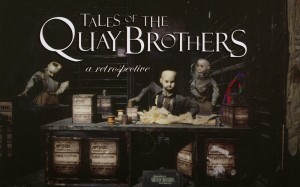 – A small reminder that the films of the Quay Brothers is screening at the Film Forum this week through January 25th. The program includes the following films:
– A small reminder that the films of the Quay Brothers is screening at the Film Forum this week through January 25th. The program includes the following films:
In Absentia (2000)
Anamorphosis (1991)
The Comb (1991)
Are We Still Married? (1991)
Dramolet (1988)
Street of Crocodiles (1986)
The Epic of Gilgamesh (1985)
Rehearsals for Extinct Anatomies (1986)
The Cabinet of Jan Svankmajer (1984)
Tales from the Vienna Woods (Stille Nacht III) (1992)
Can’t Go Wrong Without You (Stille Nacht IV) (1993)
